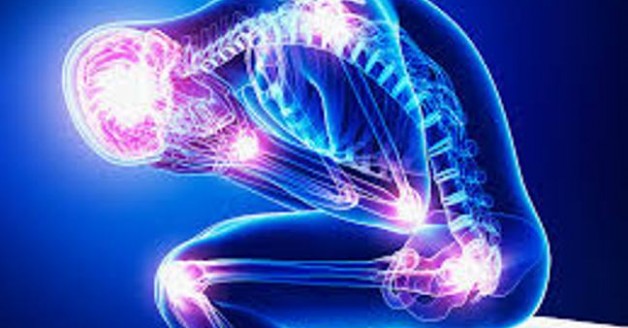If you suffer with chronic pain, exercise might be the last thing you want to do. Yet, depending on the reasons for your pain – and with your doctor’s approval – exercise may be one of the things that can help ease pain. (If you have health issues, including pain, do not begin to exercise without your doctor’s approval.)
Regular readers of EverBeautiful.com know that I have a bad back. I was apparently born with it, but it didn’t inhibit my activity level until I got older. Through my thirties and forties, I kept myself strong with exercise. That was my panacea. Exercise eased my pain and helped me recover more quickly when I had a bout of back spasms. But, relatively recently, chronic pain has made me think twice about exercising. A visit to an orthopedist led me to a physical therapist who told me that the exercising I had been doing for the past two decades was not helpful for the current state of my back. He taught me a battery of new exercises to do. (Ya gotta check with your doctor. Had I mentioned that already?) At first, I was resistant. I, who loves to weight train, didn’t feel as if I was working out hard enough. I groused and moaned, but I did the exercises and, after a few weeks, my pain became less noticeable. (And, full disclosure, I stopped doing the exercises recommended by my PT and returned to my old way of three sets of 15 reps, and guess what? My pain returned, sidelining me. Ugh. I think I learned my lesson, but I’m human. Old habits and all that.) So, I guess you could say that this post is a classic example of “do as I say and not as I do.” Sorry about that, but it’s good info. Read on …

EverBeautiful consulted with Dr. Victor Romano, a board certified orthopedic surgeon and author of Finding The Source: Maximizing Your Results – With and Without Orthopaedic Surgery. “It can become a Catch-22 situation. We don’t want to exercise because we have pain, and yet exercise will usually help you reduce the pain over the long run,” says Romano, echoing current thought.
Research has shown that exercise is an essential aspect in the treatment of chronic pain. Lack of exercise can cause a downward cycle of deconditioning and worsening pain. But exercise can help those with chronic pain engage in enjoyable and essential activities of daily living with greater ease. Stretching, cardio exercise and weight lifting are the three types of exercise most people should include in every workout, Romano says.
Doctors generally ask patients to rate their pain on a scale of one to 10. The average intensity of pain experienced for 12 or more hours over a 24-hour period is considered their baseline pain. Romano says if, during exercise, pain levels increase by more than 2 points from the baseline you should stop and modify that exercise to ensure you do not cause a flare up of your pain. (Or stop doing that exercise and try another.)
Of course, a healthy diet is also important, says Romano.
For people who suffer from chronic pain, Romano offers these exercise tips:
- Try shorter exercise periods. It is better to exercise in short bursts than in one long workout. Even five minutes is better than nothing. Everything counts. (My PT cut my exercises down from three sets of 15 reps to two sets of 10 reps. He also had me lower the amount of weights I lifted. And, yes, I resented this terribly, but learned the hard way, that it was better for me.)
- Weight training is also important for seniors and women. Research has proven that weight training is good for everyone, regardless of sex or age. Make sure to incorporate it into your exercise program. (Not sure how to begin weight training? After getting the ok from your health care practitioner – yup, I’m going to hammer this point home – speak with a fitness expert at your gym, if you have a membership. If you don’t belong to gym, you can get an equally good workout at home. Do a Google search on the subject and find a program that you think will work for you.)
- Stretching is important. Go online and find some good stretching exercises and incorporate them into your daily routine, even if you don’t exercise that day.
- Try yoga or tai chi. These programs have shown success with people with chronic pain. (My doctor offers a variety of yoga classes after office hours. Check with your doctor and, if he or she doesn’t offer yoga classes, suggest it. My doctor charges a small fee and participates in the classes that are taught by an expert. I haven’t taken any with her, but I’d feel in safe hands were I to do so.)
- Mind over matter. If you need to do an exercise that you know is going to be painful, start by taking some deep breaths and focus your energy. Take your time.
About Dr. Victor Romano
Dr. Victor Romano (http://www.romanomd.com) is an orthopedic surgeon and the author of Finding The Source: Maximizing Your Results – With and Without Orthopaedic Surgery. He is board-certified in orthopedics and sports medicine with more than 25 years of experience in the field. He graduated cum laude from the University of Notre Dame and completed medical school at the University of Loyola-Chicago.
If you would like to buy Dr. Romano’s book, click the link below:
YOU MAY ALSO LIKE:
The End of Back Pain, by Patrick A. Roth, M.D. – A Must Read for Sufferers
What Stress Does to Our Bodies
5 Non-Surgical Ways to Treat Arthritis